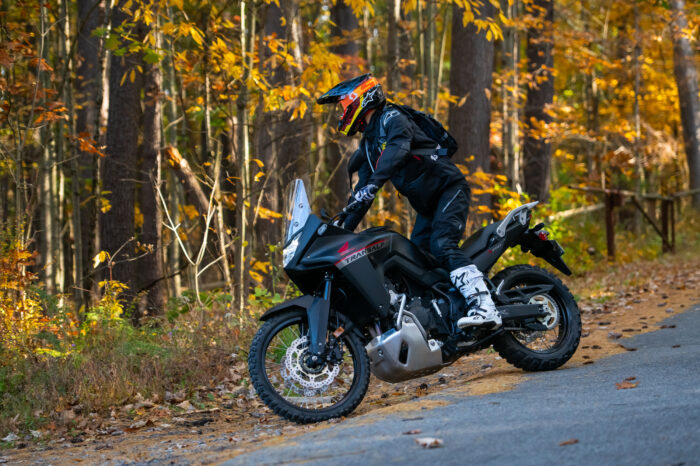Honda announced the release of the Transalp 750 in the U.S. market last month. It then invited us to test the much-anticipated ADV bike on the Backcountry Discovery Routes (BDR) PA Wilds BDR-X route.
Transalp is a lauded monicker to motorcyclists who like to venture on the rougher surfaces of dirt and gravel back roads. The original Honda Transalp hit these less-traveled venues in 1986, and the 2024 Honda XL750R Transalp evoked nostalgia as soon as I saw it. Visually, the bike looked to possess the double personality of highway cruiser and dirt bomber that the original version introduced.
I rode the 2024 Honda Transalp 750 over 2 days on varied terrain in rural central Pennsylvania, luckily catching the incredible fall hues. I rode smooth highways, windy blacktops, and dirt that ranged from tame two-track to challenging rocky sections made slick with puddles and mud. The Transalp and I covered nearly 300 miles of the 500-mile BDR-X route.
In short: The 2024 Honda Transalp 750’s dual purpose matched its dual personality. It was extremely easy to ride, allowing me to traverse more challenging sections without hesitation. The pairing of these alter egos made the Transalp a bike suitable to a wide range of abilities and styles, making the bike an appealing choice for the ADV masses.
- Engine: 755cc liquid-cooled 24.5º inline-two-cylinder four-stroke w/270º crank
- Valve train: OHC Unicam, 4 valves per cylinder, 35.5mm inlet valves, 29mm exhaust valves
- Induction: PGM-FI; 46mm throttle bodies
- Transmission: Manual 6-speed
- Clutch: Multiplate wet
- Front suspension: 43mm Showa SFF-CATM telescopic inverted fork w/ spring-preload adjustment; 7.9" travel
- Rear suspension: Pro-Link system w/ single Showa remote-reservoir shock; 7.5" travel
- Front brake: Dual 310mm "wave" discs w/ hydraulic two-piston calipers
- Rear brake: Single 256mm "wave" disc w/ hydraulic single-piston caliper
- Fuel capacity: 4.5 gal.
- Wet weight: 459 lbs.
- Ground clearance: 8.3"
- Tires: 90/90-21 (front), 150/70R-18 (rear)
- Wheelbase: 61.5"
- Seat height: 33.7"
Pros
- Extremely linear and tractable engine response
- Suspension effective over most surfaces at "adventuring" speeds
- Excellent electronic rider aids package
- Great brakes
Cons
- Low exhaust could be prone to damage
- No cruise control
- Small, uncomfortable stock footpegs
- USB-C port is under the seat
2024 Honda XL750R Transalp Review

2024 Transalp 750 Engine Characteristics

Transalp 750 Suspension Performance

2024 Honda Transalp 750 Electronics Package

Riding Modes
Quick Shifter & TFT Information Panel
XL750 R Transalp Nitpicks

Transalp 750 Chassis

Other Nitpicks
2024 Honda Transalp 750 Review: Conclusions













